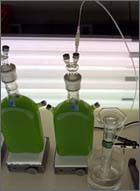 | ||
The biological hydrogen production with algae is a method of photobiological water splitting which is done in a closed photobioreactor based on the production of hydrogen as a solar fuel by algae. Algae produce hydrogen under certain conditions. In 2000 it was discovered that if C. reinhardtii algae are deprived of sulfur they will switch from the production of oxygen, as in normal photosynthesis, to the production of hydrogen.
Contents
Photosynthesis
Photosynthesis in cyanobacteria and green algae splits water into hydrogen ions and electrons. The electrons are transported over ferredoxins. Fe-Fe-hydrogenases (enzymes) combine them into hydrogen gas. In Chlamydomonas reinhardtii Photosystem II produces in direct conversion of sunlight 80% of the electrons that end up in the hydrogen gas. Light-harvesting complex photosystem II light-harvesting protein LHCBM9 promotes efficient light energy dissipation. The Fe-Fe-hydrogenases need an anaerobic environment as they are inactivated by oxygen. Fourier transform infrared spectroscopy is used to examine metabolic pathways.
Truncated antenna
The chlorophyll (Chl) antenna size in green algae is minimized, or truncated, to maximize photobiological solar conversion efficiency and H2 production. The truncated Chl antenna size minimizes absorption and wasteful dissipation of sunlight by individual cells, resulting in better light utilization efficiency and greater photosynthetic productivity by the green alga mass culture.
History
In 1939 a German researcher named Hans Gaffron, while working at the University of Chicago, observed that the algae he was studying, Chlamydomonas reinhardtii (a green-algae), would sometimes switch from the production of oxygen to the production of hydrogen. He never discovered the cause of this change and for many years other scientists failed in their attempts to discover it. In the late 1990s, professor Anastasios Melis a researcher at the University of California at Berkeley discovered that if the algae culture medium is deprived of sulfur it will switch from the production of oxygen (normal photosynthesis), to the production of hydrogen. He found that the enzyme responsible for this reaction is hydrogenase, but that the hydrogenase lost this function in the presence of oxygen. Melis found that depleting the amount of sulfur available to the algae interrupted its internal oxygen flow, allowing the hydrogenase an environment in which it can react, causing the algae to produce hydrogen. Chlamydomonas moewusii is also a good strain for the production of hydrogen.
Milestones
1997 – Professor Anastasios Melis discovered, after following Hans Gaffron's work, that the deprivation of sulfur will cause the algae to switch from producing oxygen to producing hydrogen. The enzyme, hydrogenase, he found was responsible for the reaction.
2006 – Researchers from the University of Bielefeld and the University of Queensland have genetically changed the single-cell green alga Chlamydomonas reinhardtii in such a way that it produces an especially large amount of hydrogen. The Stm6 can, in the long run, produce five times the volume made by the wild form of alga and up to 1.6-2.0 percent energy efficiency.
2007 – It was discovered that if copper is added to block oxygen generation algae will switch from the production of oxygen to hydrogen
2007 – Anastasios Melis studying solar-to-chemical energy conversion efficiency in tlaX mutants of Chlamydomonas reinhardtii, achieved 15% efficiency, demonstrating that truncated Chl antenna size would minimize wasteful dissipation of sunlight by individual cells This solar-to-chemical energy conversion process could be coupled to the production of a variety of bio-fuels including hydrogen.
2008 – Anastasios Melis studying solar-to-chemical energy conversion efficiency in tlaR mutants of Chlamydomonas reinhardtii, achieved 25% efficiency out of a theoretical maximum of 30%.
2009 – A team from the University of Tennessee, Knoxville and Oak Ridge National Laboratory stated that the process was more than 10 times more efficient as the temperature increased.
2011 – Adding a bioengineered enzyme increases the rate of algal hydrogen production by about 400 percent.
2011 – A team at Argonne's Photosynthesis Group demonstrated how platinum nanoparticles can be linked to key proteins in algae to produce hydrogen fuel five times more efficiently.
2013 – Uppsala University - In Chlamydomonas reinhardtii Photosystem II produces in direct conversion of sunlight 80% of the electrons that end up in the hydrogen gas.
Research
2008 – Scientists at the U.S. Department of Energy’s Argonne National Laboratory are currently trying to find a way to take the part of the hydrogenase enzyme that creates the hydrogen gas and introduce it into the photosynthesis process. The result would be a large amount of hydrogen gas, possibly on par with the amount of oxygen created.
2009 – Areas of research to increase efficiency include developing oxygen-tolerant FeFe-hydrogenases and increased hydrogen production rates through improved electron transfer.
As of 2009, HydroMicPro is testing plate reactors.
As of 2013, Grow Energy has developed novel system for the large-scale production of hydrogen from structural bioreactors.
2014 – Ruhr University and Max Planck Institute Enhance hydrogen production of microalgae by redirecting electrons from photosystem I to hydrogenase.
Economics
It would take about 25,000 square kilometres to be sufficient to displace gasoline use in the US. To put this in perspective, this area represents approximately 10% of the area devoted to growing soya in the US.
In 2004, the US Department of Energy issued a selling price of $2.60 per kilogram ($1.18/lb) as a goal for making renewable hydrogen economically viable. 1 kg is approximately the energy equivalent to a gallon of gasoline. To achieve this, the efficiency of light-to-hydrogen conversion must reach 10% while 2004 achieved-efficiency is only 1% and the 2004 actual selling price is estimated at $13.53 per kilogram ($6.14/lb)
According to a 2004 DOE cost estimate, for a refueling station to supply 100 cars per day, it would need 300 kg. With current technology, a 300 kg per day stand-alone system will require 110,000 m2 of pond area, 0.2 g/l cell concentration, a truncated antennae mutant and 10 cm pond depth.
Bioreactor design issues
Attempts are in progress to solve these problems via bioengineering.
